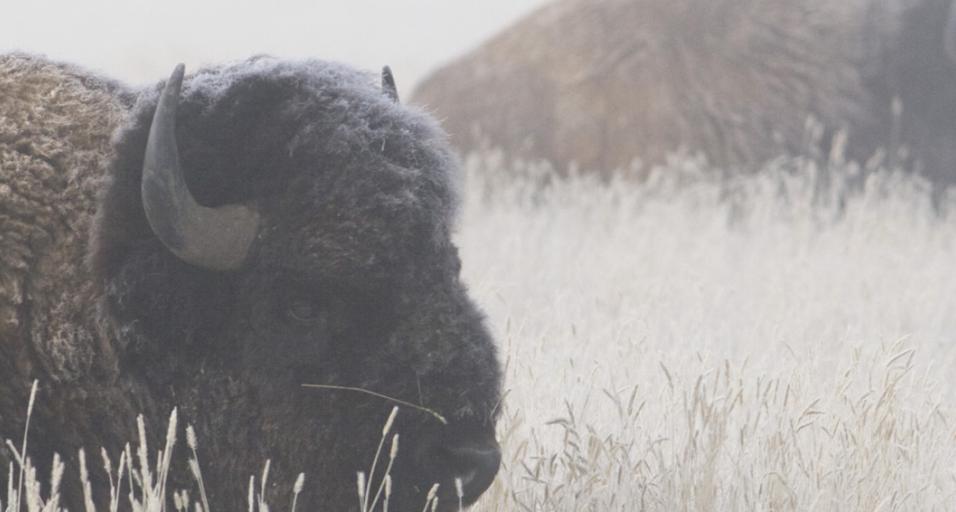Bison Hunting
Determining the size of the Jackson Bison Herd was made difficult in 2019 because only 155 bison migrated to the National Elk Refuge (NER) for winter, when normally nearly all bison in the population are found wintering there. Although it is estimated there were between 550 and 600 bison after the 2018 hunting season, only 484 bison were observed during mid winter surveys, with most bison widely dispersed on native winter ranges, and wintering in heavily forested areas.
Management of this herd is complicated because occupied habitat includes Grand Teton National Park (GTNP), the National Elk Refuge (NER) and the Bridger-Teton National Forest (BTNF). Bison remain distributed in GTNP during much of the summer and fall and are not available for hunting until they migrate to either BTNF or the NER. In the past two years, mild weather and aversion to hunting pressure on the NER have resulted in delayed movements, or little to no movement into open hunt areas, which makes achieving harvest objectives difficult. Some bull hunting occurs on BTNF land to the east of GTNP, but bison availability is intermittent and low in that area.
After the 2016 hunting season there were 546 bison observed in the Jackson Bison Herd, which was closer to the population objective of 500 than it has been since 2000. This was the result of over 10 years of hunting seasons designed to reduce herd numbers from over 1,000 bison. Although the 2017 and 2018 hunting seasons did not produce desirable harvests, additional licenses are not proposed for the 2019 season. Considerably fewer cows in the population, a lower than average calf:cow ratio, and the potential for substantial winter mortality of calves result in fewer licenses necessary to curb the growth of this herd.
Hunters can expect the regular season to run from August 15 to January 1, 2020. Like last year, the season will continue from January 2 to January 31 with National Elk Refuge (NER) permits available on a daily basis through the Jackson Regional Office through the end of the month or until supplemental feeding on the NER is deemed necessary. This will allow for additional hunting opportunities should forage and weather conditions delay the onset of supplemental feeding of elk and bison on the Refuge. A total of 125 Type 1 licenses and 50 Type 4 licenses will be issued in 2019, which is slightly fewer than 2018 levels. The post-season calf:cow ratio was below average in 2018 at 38 calves:100 cows, and the bull:cow ratio remained exceptionally high at 128 bulls:100 cows this winter.
Hunter success usually depends largely on weather, especially for cow/calf hunters, as almost all of the harvest on the Type 4 license occurs on the National Elk Refuge (NER). The majority of the harvest occurs during late December and January. Hunters wishing to hunt on the NER will have an opportunity to apply for a Refuge permit on the Wyoming Game and Fish Department’s web page beginning in July. Additional information on NER permits will be available to successful applicants by contacting the Jackson Regional Office.
Management of this herd is complicated because occupied habitat includes Grand Teton National Park (GTNP), the National Elk Refuge (NER) and the Bridger-Teton National Forest (BTNF). Bison remain distributed in GTNP during much of the summer and fall and are not available for hunting until they migrate to either BTNF or the NER. In the past two years, mild weather and aversion to hunting pressure on the NER have resulted in delayed movements, or little to no movement into open hunt areas, which makes achieving harvest objectives difficult. Some bull hunting occurs on BTNF land to the east of GTNP, but bison availability is intermittent and low in that area.
After the 2016 hunting season there were 546 bison observed in the Jackson Bison Herd, which was closer to the population objective of 500 than it has been since 2000. This was the result of over 10 years of hunting seasons designed to reduce herd numbers from over 1,000 bison. Although the 2017 and 2018 hunting seasons did not produce desirable harvests, additional licenses are not proposed for the 2019 season. Considerably fewer cows in the population, a lower than average calf:cow ratio, and the potential for substantial winter mortality of calves result in fewer licenses necessary to curb the growth of this herd.
Hunters can expect the regular season to run from August 15 to January 1, 2020. Like last year, the season will continue from January 2 to January 31 with National Elk Refuge (NER) permits available on a daily basis through the Jackson Regional Office through the end of the month or until supplemental feeding on the NER is deemed necessary. This will allow for additional hunting opportunities should forage and weather conditions delay the onset of supplemental feeding of elk and bison on the Refuge. A total of 125 Type 1 licenses and 50 Type 4 licenses will be issued in 2019, which is slightly fewer than 2018 levels. The post-season calf:cow ratio was below average in 2018 at 38 calves:100 cows, and the bull:cow ratio remained exceptionally high at 128 bulls:100 cows this winter.
Hunter success usually depends largely on weather, especially for cow/calf hunters, as almost all of the harvest on the Type 4 license occurs on the National Elk Refuge (NER). The majority of the harvest occurs during late December and January. Hunters wishing to hunt on the NER will have an opportunity to apply for a Refuge permit on the Wyoming Game and Fish Department’s web page beginning in July. Additional information on NER permits will be available to successful applicants by contacting the Jackson Regional Office.

